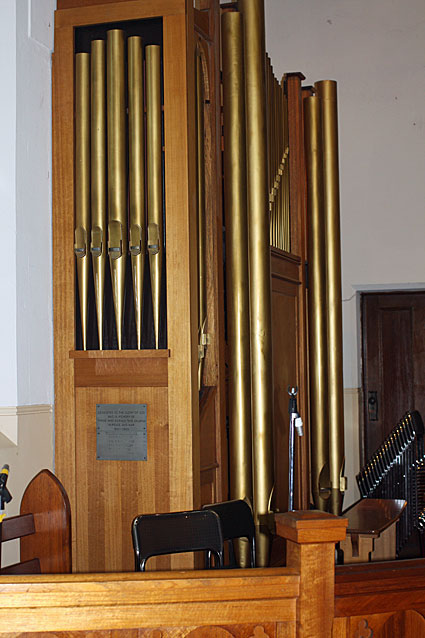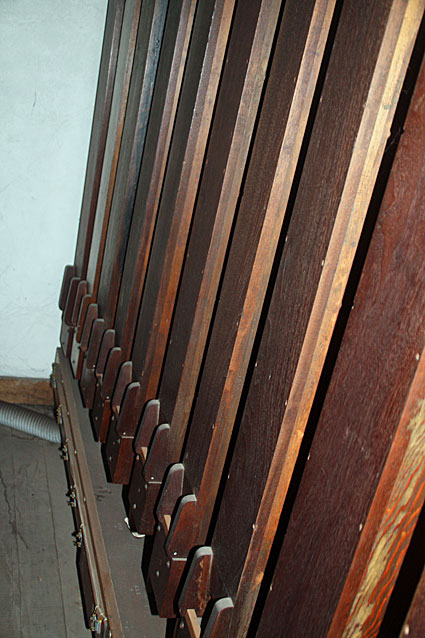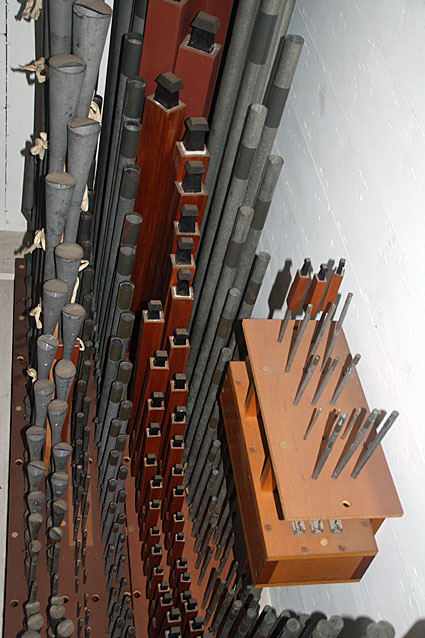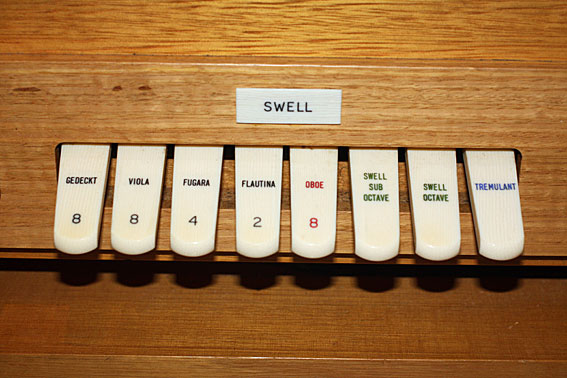
Brighton Baptist Church
[Photograph by Simon Colvin (October 2016)]
Yarra Valley Grammar School Chapel
[Photo to be supplied]
Historical and Technical Documentation by Geoffrey Cox and Simon Colvin
© OHTA 2016, 2020 (last updated March 2020)
Yarra Valley Grammar School was established in 1966 as Yarra Valley Church of England School for Boys The school subsequently became co-educational and was re-named Yarra Valley Grammar in 1999.1 The Chapel, designed by NOWarchitecture of Melbourne, was opened in 2019.2
The pipe organ was built by C.W. Andrewartha in 1944 for the Baptist Church, Brighton, where it was located in a purpose-built chamber on the left-hand side of the building.3

Brighton Baptist Church
[Photograph by Simon Colvin (October 2016)]
Founded in 1851, Brighton Baptist Church is the second oldest Baptist Church in Victoria, being preceded by the Collins-street Baptist Church. A chapel was opened for worship in 1853, becoming the Sunday School when a new church building was completed in 1858. Following cyclone damage in 1918, the 1858 building was condemned as unsafe in 1920, and the present church was opened for worship on Saturday 8 October 1921.4
Clarence William Andrewartha was born in Armadale, Vic. in 1891, and married Alice Carol Hudson in 1917. He was resident at 33 Ercildoune Street, Caulfield West and described in the electoral roles for 1942 and 1949 as a cabinet maker. He died in 1951.5
Andrewartha was active as an organ builder in Melbourne from the early 1930s (when he extended the Stop'd Diapason Bass stop at St Alban's Anglican Church, North Melbourne to make a 16ft stop on the pedal)6 until his death in 1951 (when his organ for St David's Presbyterian Church, Glenhuntly had to be completed by Charles Lomas).7 Other organs by Andrewartha include those for St Margaret's Anglican Church, Caulfield (1933), the Methodist Church, Kooyong Road, Caulfield (1935), St Stephen's Presbyterian Church, Surrey Hills (1937), the Presbyterian Church, Denbigh Road, Armadale (rebuild, 1939) and the Methodist Church, Brunswick (1942).8
The Brighton instrument was dedicated as the 'memorial pipe organ' on Sunday 17 September 1944, on which occasion the organist was Mr Allen Dempster, Mus.Bac.9 A memorial plaque records the names of the congregation members who lost their lives in the Second World War.

Memorial plaque on the organ
[Photograph by Simon Colvin (October 2016)]
The instrument originally comprised 11 speaking stops with tubular-pneumatic action:
| GREAT Open diapason Clarabella Dulciana Principal SWELL Open diapason Stop diapason Viol d'orchestra Dolce flute Oboe PEDAL Bourdon Bassflute COUPLERS Great to pedal Swell to pedal Swell to great Great super octave Swell sub Swell super |
8 8 8 4 8 8 8 4 8 16 8 |
A A |
Tubular-pneumatic action
Compass: 61/30
Slider soundboards
Balanced swell pedal
Fixed thumb and toe pistons
Unplaned plain metal pipework (by Sam Potter) fitted with tuning slides
Attached stop-key console.10
The organ was rebuilt and electrified in 1976 by Laurie Pipe Organs of Melbourne. It was re-opened at a commissioning concert by organist Douglas Lawrence and the choir of the Presbyterian Church, Toorak, on 6 March 1977.11

The pipe organ built by C.W. Andrewartha in 1944, as rebuilt in 1976 by Laurie Pipe Organs, Melbourne
[Photograph by Simon Colvin (October 2016)]
The specification of the organ, rebuilt by Laurie, was as follows:
| GREAT Open Diapason Stopped Diapason Principal Stopped Flute Fifteenth SWELL Gedeckt Viola Fugara Flautina Oboe PEDAL Bourdon Principal Flute Quint Octave Flute COUPLERS Great to Pedal Swell to Pedal Swell to Great Swell Sub Octave Swell Octave |
8 8 4 4 2 8 8 4 2 8 16 8 8 5-1/3 4 |
A B A B A B A B B B |
includes spotted metal pipework stopped wooden pipework, except for top octave wood metal metal [pipes marked 'Dul', presumably ex. Great 1944] metal [pipes marked 'Coel'] metal |
Swell tremulant
Electro-pneumatic action
Detached reverse stop-key console
Balanced mechanical swell pedal (horizontal swell shutters)
Compass: 61/30
Pedalboard: radiating and concave.12


Casework, including non-speaking pipes in the
central flat, and at the side of the organ
[Photographs by Simon Colvin (October 2016)]
Laurie supplied a new 73-note unit chest for the Great, using electro-pneumatic action and deriving all of the Great and Pedal stops from two ranks. Twelve speaking pipes in the façade comprised the bottom octave of the Open Diapason, while the lowest twelve Pedal Bourdon pipes are located at the rear of the organ chamber. The central flat and the five pipes on the side of the organ were all non-speaking.

Great pipework, including the metal top octave
of the Stopped Diapason rank
[Photograph by Simon Colvin (October 2016)]

Electro-pneumatic underaction to the Great unit chest
[Photograph by Simon Colvin (October 2016)]

Pedal Bourdon pipes at the rear of the organ chamber
[Photograph by Simon Colvin (October 2016)]
Although Andrewartha's manual compass was reportedly 61 notes, the Swell retains what appears to be an original 58-note slider chest, now using electro-pneumatic action, with a new off-note chest for the top three notes of each rank. The original Swell Open Diapason has been deleted, and the marking 'Dul' on the Fugara 4ft pipes suggests that this originated as the Great Dulciana. The marking 'Coel' on the Flautina 2ft pipes suggests that all or part of this rank may have originated as a Vox Coelestis stop on another organ.

Swell pipework, including the new top-note chest
[Photograph by Simon Colvin (October 2016)]

Pipe markings on the Swell Fugara 4ft,
suggesting that it was originally the Great Dulciana 8ft
[Photograph by Simon Colvin (October 2016)]

Pipe markings on the Swell Flautina 2ft,
suggesting that it may have originated as a Vox Coelestis stop
[Photograph by Simon Colvin (October 2016)]
Laurie supplied a new detached reverse stop-key console with a radiating-concave pedalboard. The swell box appears to be original, complete with horizontal swell shutters, although the swell pedal is mechanical.


Laurie's reverse console,
with its distinctive mechanical swell pedal
[Photographs by Simon Colvin (October 2016)]



Console stop-key details on the Laurie console
[Photographs by Simon Colvin (October 2016)]
The organ was removed to its present location in 2019 by Australian Pipe Organs Pty Ltd, who added a new Open Diapason 8ft rank and also a repeat mixture on the Great. They also made the new case and console screen.

The rebuilt and enlarged organ in its present location,
[Photograph by Daniel Bittner (June 2019)]
| GREAT Open Diapason Stopped Diapason Principal Flute Fifteenth Mixture SWELL Gedact Viola Fugara Flautina Oboe PEDAL Bourdon Principal Flute Quint Octave Flute |
8 8 4 4 2 III 8 8 4 2 8 16 8 8 5-1/3 4 |
A [2019] B C B C [2019] B A [2019] B B B |
COUPLERS
Great to Pedal
Swell to Pedal
Swell to Great
Swell Sub Octave to Great
Swell Octave to Great.
Swell tremulant
Detached stop-key console
Electro-pneumatic action.13
1 [F.W. Boreham,] Links with the Past: The Centenary of Brighton Baptist Church, 1851-1951 (Melbourne, 1951); The Age (10 October 1921), p. 8. See also: http://brightonbaptist.org.au/history/ - accessed October 2016.
2 Personal communication to G. Cox from Sarah Hobday-North, March 2020.
3 Bob Jefferson, Steve Laurie, Organ Builder: His Life and Works (Somers: author, 1998), p. 248.
4 [F.W. Boreham,] Links with the Past: The Centenary of Brighton Baptist Church, 1851-1951 (Melbourne, 1951); The Age (10 October 1921), p. 8; http://brightonbaptist.org.au/history/ - accessed October 2016.
5 Ancestry.com. Australia, Birth Index, 1788-1922 [database on-line]; Australia, Marriage Index, 1788-1950 [database on-line]; Australia, Electoral Rolls, 1903-1980 [database on-line]; Australia, Death Index, 1787-1985 [database on-line]. Provo, UT, USA: Ancestry.com Operations, Inc., 2010.
6 E.N. Matthews, Colonial Organs and Organbuilders (Carlton: Melbourne University Press, 1969), p. 141.
7 Jefferson, op. cit., p. 259. This instrument is now at St Anthony's Catholic Church, Alphington.
8 The Argus (8 June 1935), p. 21; John Maidment, Gazetteer of Victorian Pipe Organs – http://www.ohta.org.au/gaz/GAZETTEER-OF-VICTORIAN-PIPE-ORGANS-May-2015.pdf - accessed October 2016.
9 The Argus (16 September 1944), p. 15.
10 Specification noted by John Maidment, 1966.
11 http://www.brightonbaptist.org.au/history/ - accessed October 2016.
12 Specification noted by Simon Colvin and Geoffrey Cox, 18 October 2016.
13 Specification and details supplied by Daniel Bittner, March 2020.